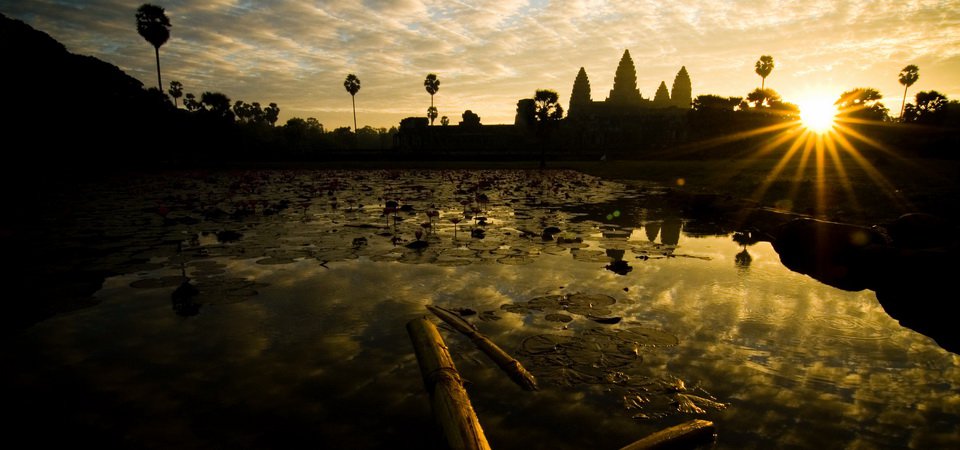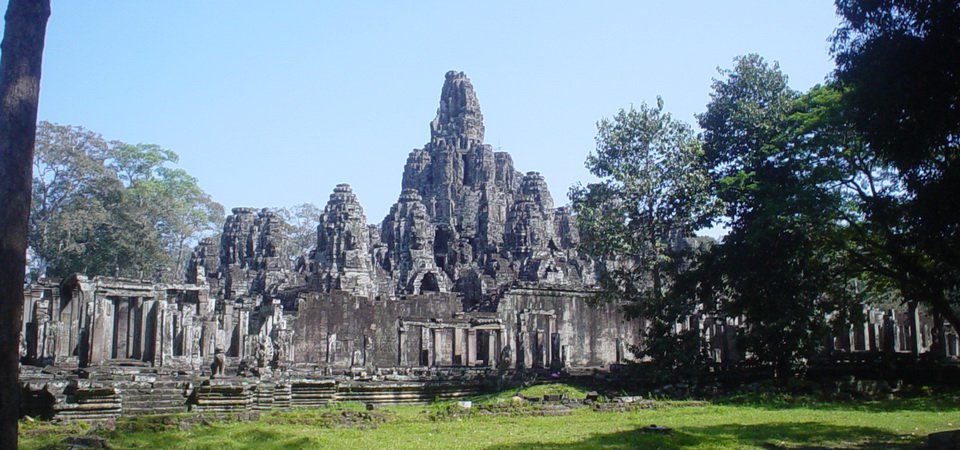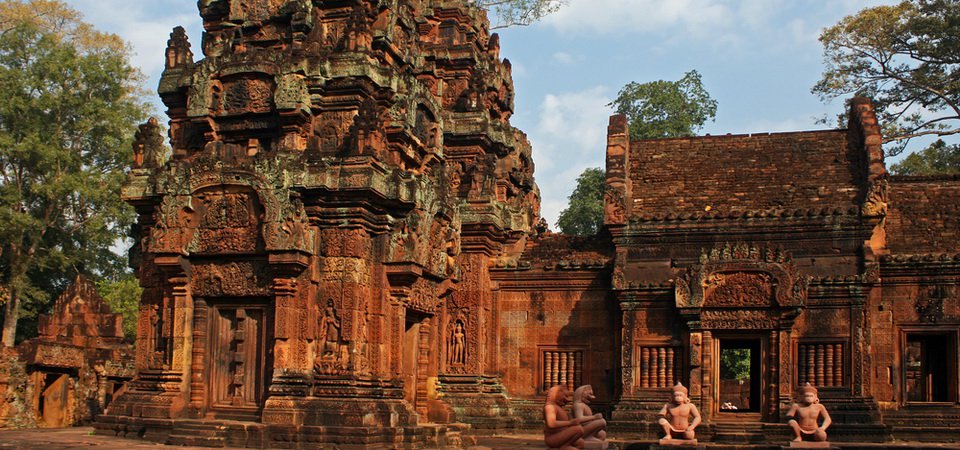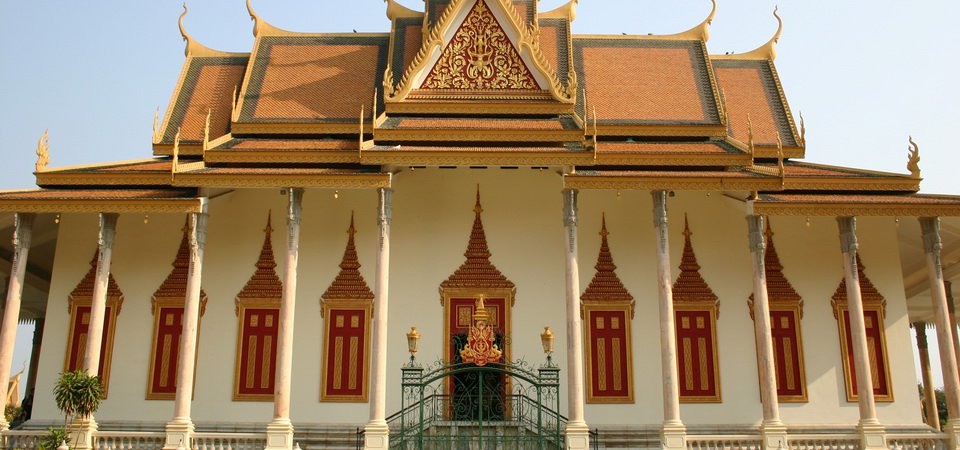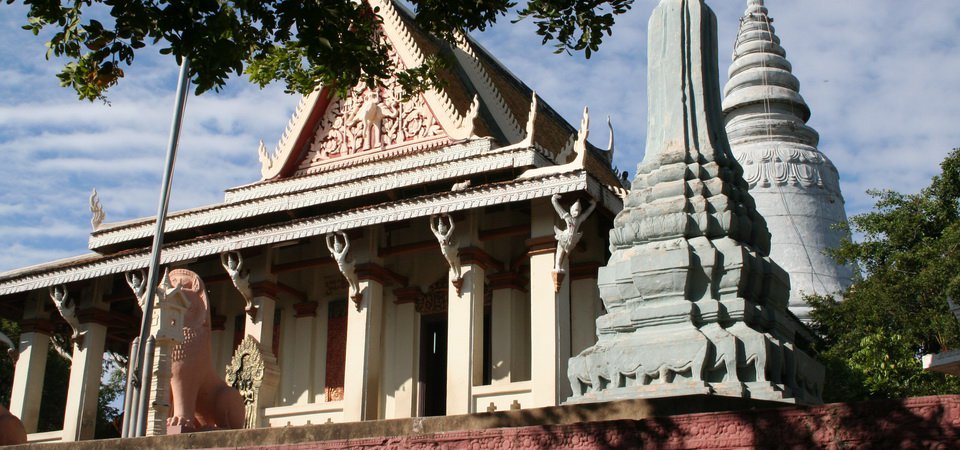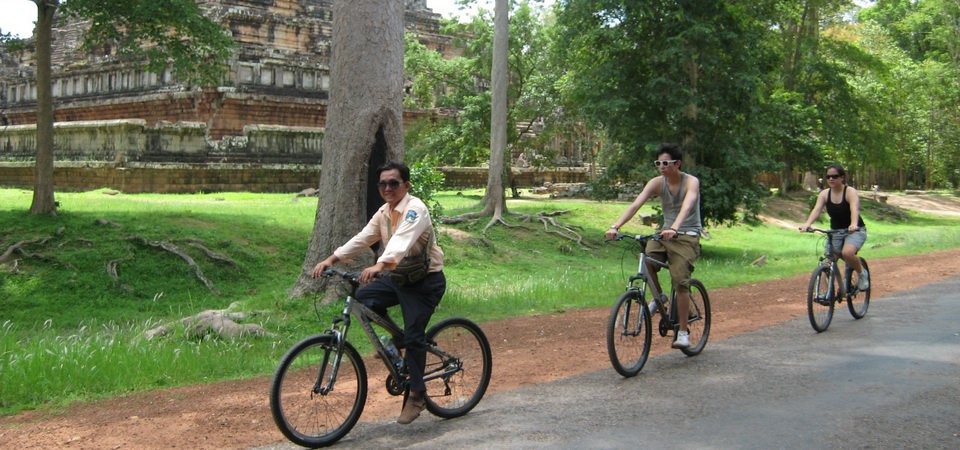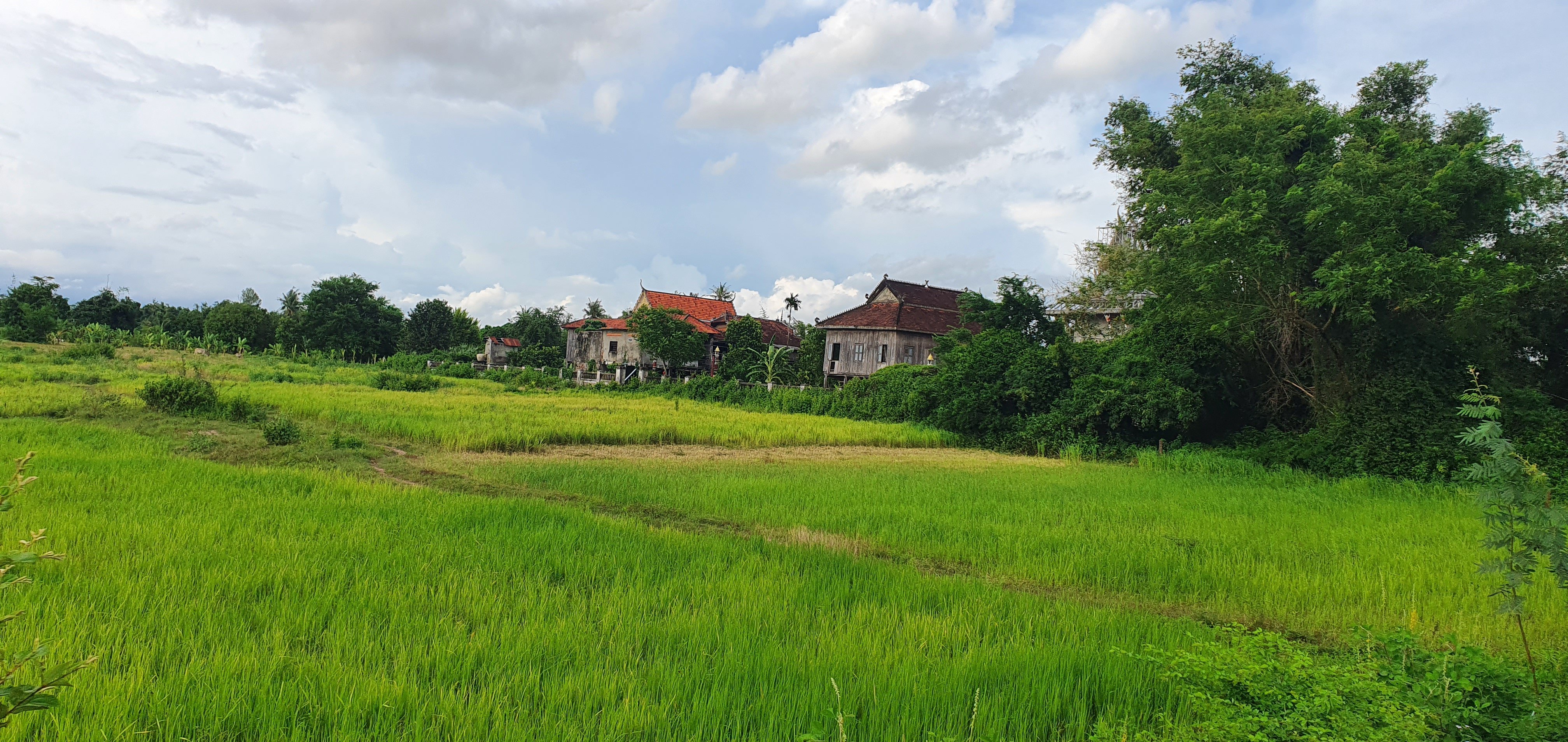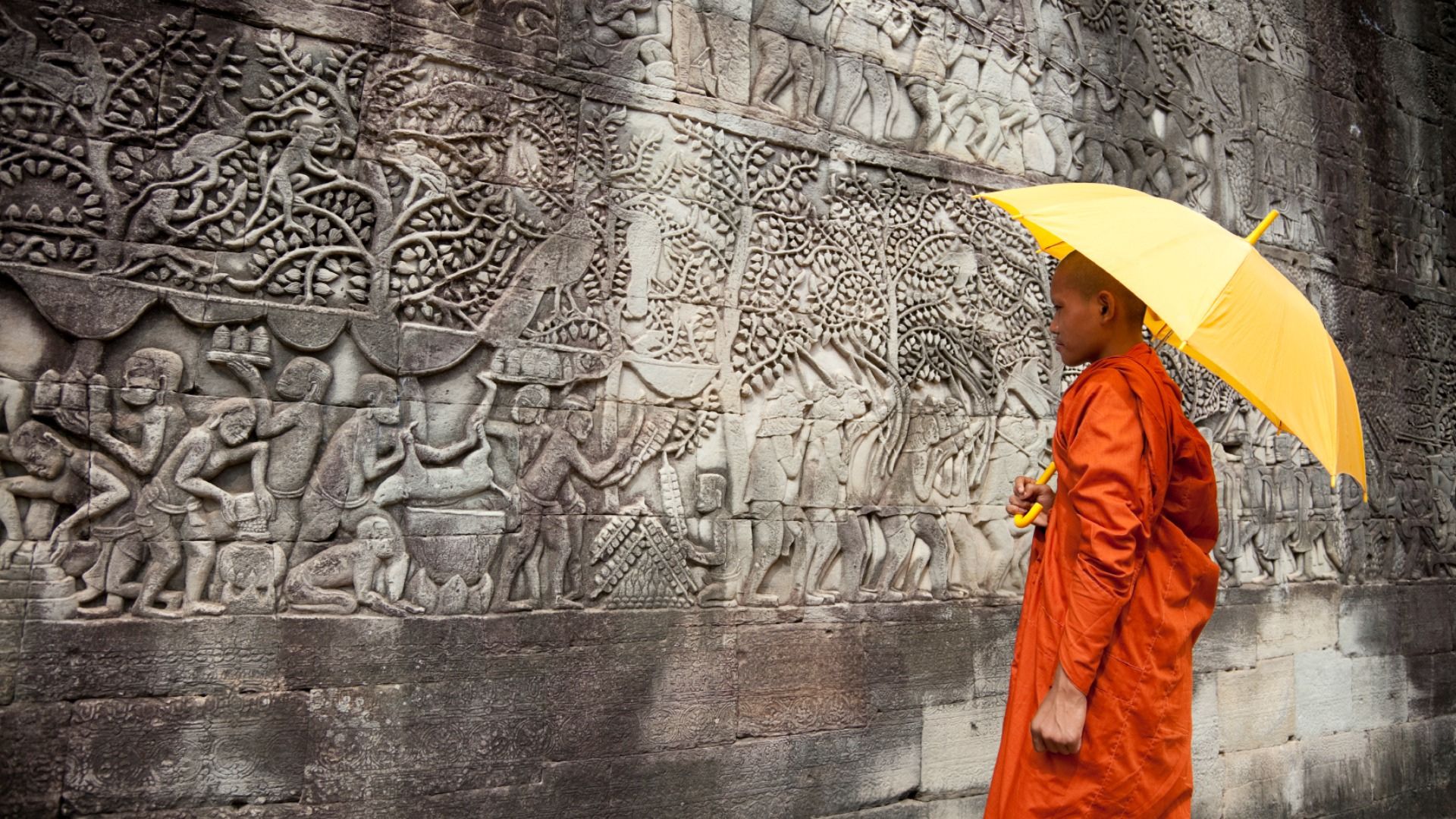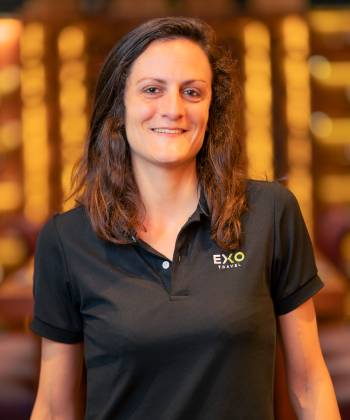Embrace the wonders of Cambodia and ensure they are here for many years to come. Travel responsibly to experience a culture steeped in tradition yet struggling to overcome a tragic past. Support inspiring locals and organizations working to promote the richness of Khmer heritage and create a better future.
Itinerary
📍 Siem Reap Airport - Siem Reap (53 km): 1 hr & 15 mins
Begin this 10-day Cambodia tour with the arrival in Siem Reap. Greeted by a local English speaking guide, you will be accompanied to the hotel for check in.
Depending on the arrival time, there may be enough time to relax and recuperate after the flight or to discover a little of Siem Reap on a stroll through its beautiful pagodas and colorful markets.
Starting at 16:00, begin the introduction at the Shrine to Ya Tep: Beneath a tree on an island in the middle of the road leading into Siem Reap sits a sandstone image believed by locals to contain the spirit of Ya Tep, a neak ta (ancestral spirit) that is believed by locals to protect the town of Siem Reap.
Just beside Ya Tep lies Preak Ang Chek and Preak Angchom, a popular Buddhist shrine surrounded by stories of power and indestructibility. Preak Ang Chek and Preak Angchom have also come to fame because of the fortune teller at the shrine. Visit this palm reader and learn what the future holds!
Continue onwards and learn about Spirit Houses, which are common in Buddist countries across Southeast Asia, including Cambodia, although they likely predate Buddhism and belong to the animist religious practices of the early Khmer. The Royal Crusade for Independence Gardens are beautiful to walk through, and host a colony of giant fruit bats. Sites such as the Raffles Grand Hotel d’Angkor, the Royal Residence, a statue of a Deva (God) from Angkor Thom, and Wat Preah Prom Rath are all lovely sites to be seen along the way.
Finish the walking tour along the riverside opposite Psar Chas, the Old Market. While the south side of the market has largely been given over to stalls selling souvenirs to tourists, much of the market still caters to a local clientele who shop here for everything from fresh produce and household supplies to motorbike parts. Along the riverside are a number of stalls selling various street foods, including fruit smoothies, noodle soup, and roti pancakes. Grab a snack if you wish, enjoy a stroll around the market, or ask the guide to hail a remork to return to the hotel.
Overnight in Siem Reap.
Inclusions:
📍 Siem Reap – Angkor Temples (06 km): 15 mins
After early breakfast, pay a visit by Remork to one of the complex’s most illustrious temples: Ta Prohm. Built between the 12th-13th centuries, Ta Prohm is unique in that it is overgrown by jungle, trees, vines, and with many parts crumbling to the ground, it is one of the most picturesque Angkor temples. Alternatively, depending on the season and the crowds, you may wish to visit Preah Khan temple. Built by the same king in a similar style, this larger temple complex is also largely left in ruins and its labyrinthian layout and fewer visitors’ makes a more intimate experience even in the high season months. (Note: Talk to your guide the morning of your visit to see which temple you should visit depending on the month of your visit.)
Then continue the explorations of Angkor with a visit to the ancient city of Angkor Thom. Enter through the South Gate, an impressive stone gate adorned with three-headed elephants, giant faces, and a row of 54 gods and demons, each holding a sacred Naga snake along the bridge leading into the city. Continue from here to the centrally-located Bayon temple. This 12th century masterpiece is known for its dozens of face-carved towers depicting King Jayavarman VII in the likeness of the Buddha. The nearby Terrace of the Elephants and Terrace of the Leper King (featuring intricate and unique carvings) are also must-visit attractions of Angkor Thom.
Lunch will be served at a local social enterprise restaurant providing disadvantaged youths, and underprivileged adults, professional training and employment in the hospitality industry. Learn about its efforts while dining.
In the afternoon, continue our journey to the Angkor Archaeological Park for a first glimpse of the legendary Angkor Wat. Built during the reign of King Suryavarman II in the early 12th century, Angkor Wat is constructed to symbolize Mount Meru, the Hindu home of the gods. Inside, the walls are covered with stone carvings and bas-reliefs depicting Hindu mythology and the wars Suryavarman II fought during his reign. Construction of the temple, which is featured on Cambodia’s flag, is thought to have taken around thirty years of intensive labor.
As the only west-facing temple, Angkor Wat is best to visit (and photograph) in the late afternoon, arriving around 14:30. Exiting the temple with the late afternoon sun shining on the Vishnu image discovered beneath the temple’s central sanctuary is a magical sight to behold and a fitting end to your exploration of the temple built by King Suryavarman, whose name translates to “protected by the sun”.
Overnight in Siem Reap.
Inclusions:
☕ Breakfast, 🥘 Lunch
Start Day 3 with a 25-minute drive out to a local village. A western-style breakfast will be packed and, upon arrival, can be shared alongside a local family. This meet and greet will provide excellent insights into the everyday life of the Cambodian countryside.
After breakfast, take a 30 minute ox cart ride through the village towards the local market to learn all about Cambodian vegetables, herbs, fruits, and other local produce. Continue 1km by foot through the picturesque countryside village, stopping off to meet and observe the local community along the way. Activities (planting, harvesting, weaving, etc.) vary depending on the season. End the morning at the local pagoda with a special water blessing by Buddhist monks.
Next, head to the Tonlé Sap Lake, where you will have the opportunity to learn about life on the lake. Drive past expansive rice fields and through local villages where rice and fish can frequently be spotted drying alongside the road.
Gain a better understanding of the local lifestyle with lunch in a family house. This is a unique opportunity to gain first-hand experience of the way of life of the local people- sitting inside a stilted house while watching the boats pass outside.
Next, board a private wooden vessel for a boat trip along a canal that leads to the Tonle Sap Lake.
Cruise along the canal with houses on either side: depending on the time of your visit, the houses will either have immediate access to the water or stand perched on stilts high above the ground, a phenomena caused by the annual rising and receding waters of the Tonle Sap Lake, Southeast Asia’s largest lake. Pass by the boats and nets used by local fishermen, some of whom you may spot fishing in the waters through which the boat passes. As you near the lake, you will see floating houses that move location with the annual ebb and flow of the lake’s waters.
(Note: Due to fluctuating water levels on the lake and canals, the village visited will depend on the date and water levels at that time).
Return to your hotel for a short refreshment.
19:30 This evening attended a stunning performance of ‘Phare, the Cambodian Circus’. Starting in 2000, professional artists of Phare Ponleu Selpak (PPS) will perform an inspiring show suitable for people of all ages.
Set up in Battambang in 1994 by young returnee Cambodians from the refugee camps who learned about using art as a means of coping with trauma, PPS has played an influential role in promoting and developing Khmer culture over the years after the Khmer Rouge genocide. The hour-long show mixes traditional and modern theater, music, dance, acrobatics, juggling and contortion performed in a story about Cambodian lives and society. Student performances can still be seen twice weekly in Battambang but now the circus has arrived.
After the show, your driver will bring you safely to your hotel or, at your choice, drop you off at Pub Street or in the city center of Siem Reap.
Overnight in Siem Reap.
Inclusions:
☕ Breakfast, 🥘 Lunch
📍 Siem Reap – Banteay Chhmar (160 km): 2 hrs & 30 mins
After picking up at the hotel, we started our rural drive through the Cambodian countryside to Banteay Chhmar, a remote, expansive, and rarely visited temple complex.
Accommodation for the next two nights will be at a traditional, local homestay. A memorable and intimate encounter, this will be the perfect means of experiencing daily life and learning the local customs of a typical Khmer village. After reaching the local homestay, sit down for a traditional lunch prepared by a local women’s group, under a straw hut in the village.
In the early afternoon, visit the main temple compound of Banteay Chhmar, one of the largest built in the Angkor era that sees very few visitors. The main temple at Banteay Chhmar is surrounded by 9 satellite temples, most of which have received very little study and documentation. The carvings on the outside of the inner sanctuary walls are simply stunning, and every step through the complex provides a fascinating image of stone consumed by nature: a spectacular visit with Bayon-style towers, walls, and enclosures cloaked in vegetation.
The day will wrap up at Ta Prohm temple, where a memorable night-time picnic will ensue. Enjoy a torch-lit dinner under the stars, accompanied by the gaze of Bayon-style towers. A traditional Khmer music performance played by local villagers will conclude the amazing first night in the serene setting of rural Cambodia.
Overnight in Banteay Chhmar at a local homestay.
Inclusions:
☕ Breakfast, 🥘 Lunch, 🍗 Dinner
Wake up to the sights and sounds of a rural Cambodian farming village, accompanied by a delicious breakfast prepared by the hosts.
Start the morning with a walking tour through the Banteay Chhmar local market. The local guide will explain the traditional way of life in the area, including fishing, beekeeping, weaving, and rice farming.
Ride through the surrounding countryside of the village in an ox-cart, passing the paddy fields, sugar palm trees, and other typical Cambodian landscapes. Continue on to the Pol Pot Baray (an irrigation dam built by the Khmer Rouge) via kuyon (a type of local tractor), where a picnic lunch will be held on a wooden platform at the baray. Relax and enjoy the peaceful settings in a hammock before departing, and on the way back to the village, visit beekeeping and cassava farms en-route.
After arriving back at the local village and homestay, wind down with a meal prepared by the host family, along with a display of how rice is processed following the harvest.
Overnight in Banteay Chhmar at a local homestay.
Inclusions:
☕ Breakfast, 🥘 Lunch, 🍗 Dinner
📍 Banteay Chhmar - Battambang (141 km) 3 hrs
After breakfast at a community based tourism restaurant, depart the village and travel 12km by kuyon through small villages, water reservoirs, and picturesque rice fields to Banteay Torp temple. The name of this 13th Century temple is thought to mean ‘Fortress of the Army’ and it was built during the same period as the Banteay Chhmar temple complex. It is believed to have been built as a tribute to the Khmer army for their defeat of the Cham army leading to Khmer control of the region. The site consists of three large, precarious-looking stone towers and a nearby pagoda with beautiful wall paintings.
After having a picnic lunch at this serene temple, continue journeying onwards to Battambang. The remainder of the day can be spent at one’s leisure; enjoying the hotel pool or independently exploring Battambang’s old streets.
Overnight in Battambang.
Inclusions:
☕ Breakfast, 🥘 Lunch
Begins with a fun morning cycle ride around the local villages surrounding Battambang with SoksaBike, a social enterprise set up to provide scenic and informative bike rides through the local countryside. During the 30km cycle tour there are plenty of stops to learn how the locals produce rice paper, prahok (typical Cambodian fish paste), grolan (sticky rice stuffed in bamboo), and other Cambodian treats.
Lunch will be held at Jaan Bai. A social enterprise restaurant, Jaan Bai provides training and employment for local youth, with all profits going to the overall sustainability of the Cambodian Children’s Trust.
After lunch, take a ride on the Bamboo Train. The Bamboo Train was set up by the villagers in order to facilitate the transportation of goods and persons after regular trains ceased running. The “train” itself is very basic: a bamboo platform on 4-wheels that is powered by a small motor. Sitting on the platform (we will provide some cushions for your comfort), you will travel the 8 km to the next station through beautiful landscape and rice paddies (depending on season of visit). A true rollercoaster ride without loops! (Note: the bamboo train is occasionally not in operation without prior notice).
In the late afternoon, head to Phnom Sampeau, meaning “Ship Hill” in Khmer due to its distinctive shape; it is one of the few hills standing out in this otherwise pancake-flat plain. From the small temple on the top, you will have a fantastic view over the typical landscape of paddy fields and sugar palm trees. Phnom Sampeau is home to the notorious killing caves, which are cruel reminders of Cambodia’s troubled past. Serenity and inhumanity represented in one place make this an interesting visit. Your visit will last until dusk, when millions of bats emerge from a cave and create patterns as they fly in tandem across the sky – a nightly spectacular show of nature !
Overnight in Battambang.
Inclusions:
☕ Breakfast, 🥘 Lunch
📍 Battambang – Phnom Penh (330 km): 5 hrs
Depart early for the transfer from Battambang to Phnom Penh. Your first stop is Kampong Chhnang, known for its traditional pottery, with many kilns at work in this province. Stop in a village near Kampong Chhnang town to see the different aspects of pottery making and also experience the production of traditional rice wine.
Continue to Oudong, the former royal capital of Cambodia after the fall of Angkor. The drive passes through many rural villages and pagodas until you see the temple mountain with its dozens of stupas from afar. Upon arrival at Oudong, enjoy a traditional Khmer lunch at a picnic hammock huts at the foot of the hill: there are literally thousands of hammocks located around the base of the mountain!
Then, climb the stairs to the top of Oudong Mountain and enjoy magnificent views over the plains below. Your guide will explain the history of the area and its buildings, as well as the religious culture of the Cambodian people. Take your time to soak in the magnificent views over the plains below.
Before heading to Phnom Penh stop to take a look at the spectacular Vipassana Dhura Buddhist Meditation Center, also located in Oudong. Your guide can explain more about the school of Vipassana (Insight Meditation) as you tour the center. Don’t forget to see the impressive jade Buddha, the mummified monk and the brightly painted walls telling the story of the Ramayana, the epic Sanskrit poem that decorates many pagodas around the country.
From here, it is not far to Phnom Penh, which you will reach in the late afternoon. Check into your hotel.
The evening is at leisure.
Phnom Penh was once considered one of the most beautiful cities in the Orient, and despite its turbulent history and recent development, it still retains a colonial charm. Cambodia’s capital is a bustling city, majestically located at the confluence of the mighty rivers of the Mekong and Tonlé Sap. Wide tree-lined boulevards and many colonial-era buildings reflect the glorious days and add to the allure of the city, where Asian and Western traditions meet in a fascinating way.
Overnight in Phnom Penh.
Inclusions:
☕ Breakfast, 🥘 Lunch
Get to know Phnom Penh, a vibrant city steeped in history. On first appearance it appears to be a busy, soulless capital, but through carefully-selected tours the soul of Phnom Penh reveals itself.
Commence the sightseeing in Phnom Penh with a visit to the Royal Palace located in the city center. Explore the majestic compound and step back in time to when the Kingdom flourished. See the spectacular reception halls and historic royal costumes. The elegant Silver Pagoda, with its solid-silver floor, is a reminder of the prosperity of the former royal families.
Continue to the adjacent National Museum. Housed in a beautiful old building surrounded by tropical gardens, the museum is a tranquil oasis in the busy city center. Go inside to see seemingly endless displays of art and artifacts dating back to the pre-Angkorian era. Continue by traveling to the hilltop pagoda of Wat Phnom, for which the capital was named. Although not the most beautiful temple, the hilltop offers fabulous views of the city below.
In the afternoon, explore the more recent history of Cambodia. Visit Tuol Sleng Prison (S-21) and the Killing Fields at Choeung Ek, sites used by the Khmer Rouge regime when they ravaged the country in the 1970s and 80s. The lasting effects of this tragic period are still being felt. Although the visits are somber, studying this era is important in helping to understand present-day Cambodia.
Note: All visitors to Toul Sleng Genocide Museum are required to wear modest clothing: no short pants or short skirts (knees must be covered) and no sleeveless shirts (shoulders must be covered). See-through clothing will also not be allowed.
Overnight in Phnom Penh.
Inclusions:
☕ Breakfast
📍 Phnom Penh Hotel - Airport (10 km): 30 mins
Depending on the departing flight, there may be time left for browsing the colorful markets of Phnom Penh. Visit the Central Market, an art deco landmark and one of the largest markets in Cambodia, housing everything from clothes and souvenirs to jewelry and food. Visitors may also visit the Russian Market, one of the best places in the city for wood and stone carvings, jewelry, clothes, and Cambodian silk souvenirs.
Wrap up this 10 day Cambodia tour with a transfer to Phnom Penh international airport for the departing flight.
Inclusions:
☕ Breakfast
You might also like...
Here is a selection of products that may also fit the needs of your client.
Become a partner-
You might also like...
Here is a selection of products that may also fit the needs of your client.
Become a partner -
-
-
-
-
Get in touch
Our sales team is on hand to ensure that the process of working with us is as smooth as possible. If you should have any questions, feel free to reach out to them.



